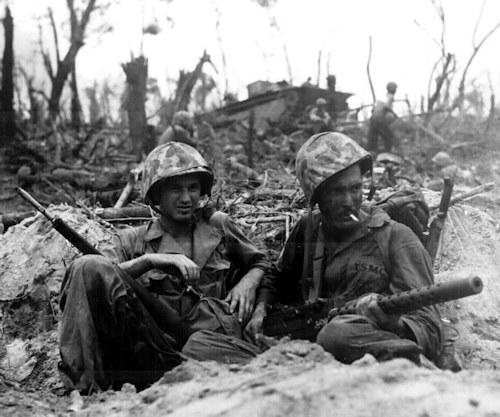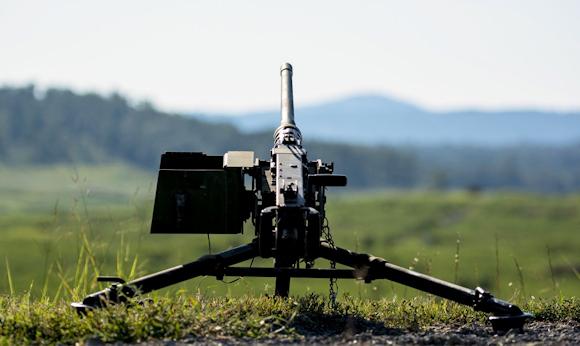The Browning M-2HB is the most widespread and long-lived HMG (Heavy Machine Gun) western.
The birth of the first heavy machine guns dates back to the end of the First World War, when the appearance on the battlefields of the tank and the airplane had rendered the normal machine-gun calibres ineffective (the same ones adopted for the ordering rifles). It was necessary to have a higher caliber that offered greater ballistic performance.
The commander of the American Expeditionary Corps in Europe, General John J. Pershing, came to these conclusions and requested the Army Ordinance Department to design a calibrated machine gun with a ammunition at least half an inch in diameter (.50 or 12,7 mm) and with a mouth speed of at least 800 m / s.
The experience on the battlefields of the western front had highlighted the effectiveness of the French incendiary ammunition in caliber 11x53R, used to destroy the balloons and built starting from the blow from 11 mm Gras (11x59R).
It was decided to produce eight Colt machine guns calibrated with this ammunition, however the ballistic performances were considered insufficient and the experimentation ceased.
 The American designer John Moses Browning, already in the 1917, began to design a larger caliber version of the Browning M-1919 caliber .30-06 Springfield, chambered just with the .50 coup and commissioned its construction at the Winchester Repeating Arms Company, which decided to build the new ammunition starting from the .30-06 Springfield, through an enlargement of the same.
The American designer John Moses Browning, already in the 1917, began to design a larger caliber version of the Browning M-1919 caliber .30-06 Springfield, chambered just with the .50 coup and commissioned its construction at the Winchester Repeating Arms Company, which decided to build the new ammunition starting from the .30-06 Springfield, through an enlargement of the same.
The experimentation of the new machine gun took place in the 1918. The weapon had a fire rate of 500 strokes / min. and a speed of blow to the mouth of 700 m / s: performance still below expectations.
The turning point came when the Winchester technicians were able to dispose of the German ammunition caliber 13,2 mm TuF (Tank und Flieger) and 13,2x92SR, developed for the Mauser Tankgewehr M-1918 counter-cannon.
Thanks to experimentation with German shots, the American technicians were able to make a new .50 shot with an 99 mm case (12,7x99 mm), and a speed at the mouth of 840 m / s.
Once the new ammunition was developed, John Moses Browning also finished designing the new heavy machine gun named M-1921, water-cooled for land use (the aircraft version lacked it).

In the 1923 it was adopted by the US Army as Model 1921, for use as a anti-tank and anti-aircraft weapon. In the 1930 a slightly modified version known as M-1921A1 was adopted.
Subsequently further changes were made, concerning the possibility or not of using water cooling and an easily reversible feeding mode. The US Army introduced the machine gun so modified with the name M-2, with water cooling in an anti-aircraft version and without cooling system as an aerial weapon.
A further variant with air-cooled and heavier barrel than the standard one was classified as M-2HB (Heavy Barrel), this arrangement made it possible to compensate for the loss of the effective water cooling allowing to reduce the overall weight of the weapon from 55 kg to 38 kg.
During the Second World War about 2 millions of copies were produced of which at least 400 thousand in the M-2HB version.
The fire rate of the M-2HB was 400 / 600 strokes / min., While the version for aeronautical use, the AN / M-2 (Army / Navy), had a fire rate of 750-850 hits / min .: this version became the most widespread machine gun on board almost all American aircraft during the war, both as an offensive weapon in fighters and as a defensive weapon on bombers.
 The M-2HB is essentially used in the terrestrial environment, mounted on light vehicles or on APC and MBT as a secondary weapon.
The M-2HB is essentially used in the terrestrial environment, mounted on light vehicles or on APC and MBT as a secondary weapon.
During the American commitment in Southeast Asia, some M-2 were equipped with optics to be used as heavy sniper rifle.
A version with a higher rate of fire is also developed, the AN / M-3 which, thanks to an acceleration mechanism of the conveyor belt feed (feed booster) allows to deliver almost 1200 strokes / min; the M-3 was widely used during the Korean War on the F-86 SABERS; F-84 THUNDERJET and F-80 SHOOTING STAR, but also equipped different versions of the G-91.
Currently, the M-3 - with different designations such as XM-213 / M-213, GAU-15 / A, GAU-16 / A, GAU-18 / A, GAU-21 - equips the USSOCOM helicopters.
The M-2 / M-3, with standard M-33 FMJ ball munitions from 706,7 grains (45,8 grams) with V ° equal to 890 m / s and with an energy of 18.143 Joules, have a useful range of 1.800 meters and a maximum range of 2.500 meters. Among the American soldiers there is the saying: when the M-2 speaks, everybody listens.
In the 2010 the US Army, after a few years of experimentation, improved the M-2HB reaching the M-2A1 version, equipped with a QCB kit (Quick Change Barrel) for the quick change of the barrel, of a modified shutter, of a manual safety and flame retardant to 4 prongs.
The Browning M-2 / M-3 are currently the most widespread heavy machine guns ever.

Photo: US Army / web / US Marine Corps












